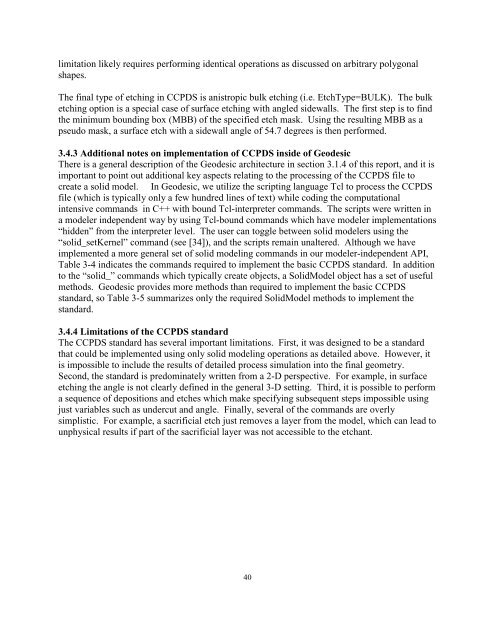Advanced CAD System for Electromagnetic MEMS Interactive Analysis
Advanced CAD System for Electromagnetic MEMS Interactive Analysis
Advanced CAD System for Electromagnetic MEMS Interactive Analysis
You also want an ePaper? Increase the reach of your titles
YUMPU automatically turns print PDFs into web optimized ePapers that Google loves.
limitation likely requires per<strong>for</strong>ming identical operations as discussed on arbitrary polygonal<br />
shapes.<br />
The final type of etching in CCPDS is anistropic bulk etching (i.e. EtchType=BULK). The bulk<br />
etching option is a special case of surface etching with angled sidewalls. The first step is to find<br />
the minimum bounding box (MBB) of the specified etch mask. Using the resulting MBB as a<br />
pseudo mask, a surface etch with a sidewall angle of 54.7 degrees is then per<strong>for</strong>med.<br />
3.4.3 Additional notes on implementation of CCPDS inside of Geodesic<br />
There is a general description of the Geodesic architecture in section 3.1.4 of this report, and it is<br />
important to point out additional key aspects relating to the processing of the CCPDS file to<br />
create a solid model. In Geodesic, we utilize the scripting language Tcl to process the CCPDS<br />
file (which is typically only a few hundred lines of text) while coding the computational<br />
intensive commands in C++ with bound Tcl-interpreter commands. The scripts were written in<br />
a modeler independent way by using Tcl-bound commands which have modeler implementations<br />
“hidden” from the interpreter level. The user can toggle between solid modelers using the<br />
“solid_setKernel” command (see [34]), and the scripts remain unaltered. Although we have<br />
implemented a more general set of solid modeling commands in our modeler-independent API,<br />
Table 3-4 indicates the commands required to implement the basic CCPDS standard. In addition<br />
to the “solid_” commands which typically create objects, a SolidModel object has a set of useful<br />
methods. Geodesic provides more methods than required to implement the basic CCPDS<br />
standard, so Table 3-5 summarizes only the required SolidModel methods to implement the<br />
standard.<br />
3.4.4 Limitations of the CCPDS standard<br />
The CCPDS standard has several important limitations. First, it was designed to be a standard<br />
that could be implemented using only solid modeling operations as detailed above. However, it<br />
is impossible to include the results of detailed process simulation into the final geometry.<br />
Second, the standard is predominately written from a 2-D perspective. For example, in surface<br />
etching the angle is not clearly defined in the general 3-D setting. Third, it is possible to per<strong>for</strong>m<br />
a sequence of depositions and etches which make specifying subsequent steps impossible using<br />
just variables such as undercut and angle. Finally, several of the commands are overly<br />
simplistic. For example, a sacrificial etch just removes a layer from the model, which can lead to<br />
unphysical results if part of the sacrificial layer was not accessible to the etchant.<br />
40
















